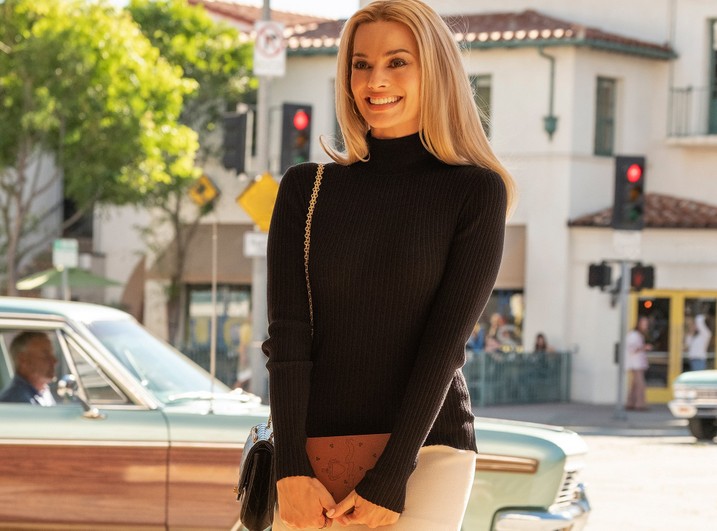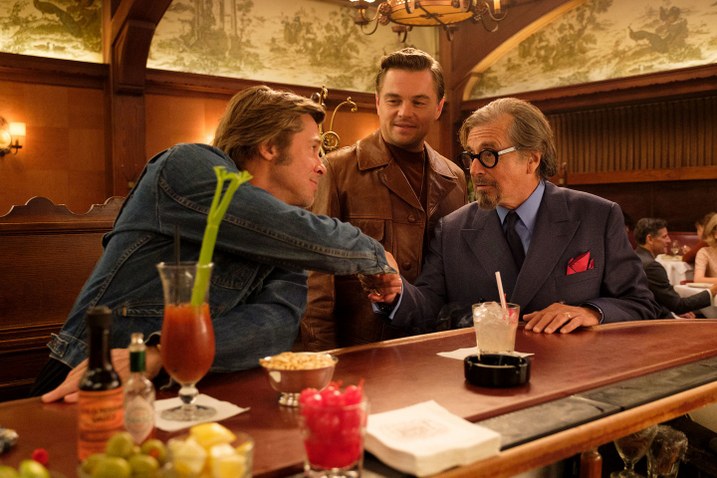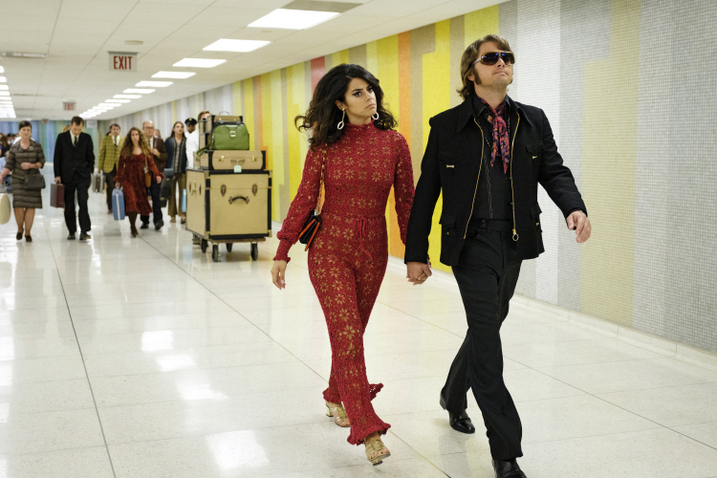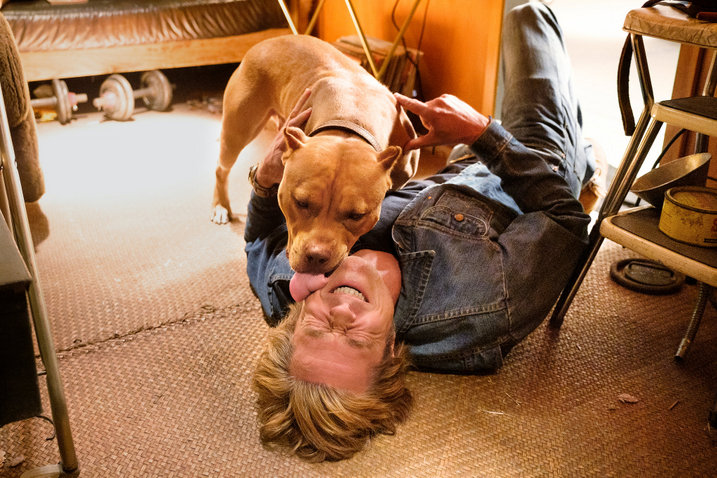Once Upon A Time In Hollywood (Blu-ray Review)
 How does Quentin Tarantino deal with getting older? Based on his many interviews in recent years, it’s pretty simple; he plans to retire. Much has been made about Tarantino’s thoughts on hanging up his director spurs after he’s completed ten films. With his 9th film, the utterly compelling Once Upon A Time… In Hollywood, I’m starting to understand why. Here’s a film serving as a tribute to the end of Hollywood’s golden age and its innocence. It tackles the relevance of aging stars and filmmakers through rose-colored glasses when considering the sordid history of Tinseltown. The result is a funny, incredibly well-filmed ensemble movie, highlighted by three central performances, and serving as another historical fantasy only Tarantino could deliver. Now the film arrives on Blu-ray for all to enjoy, including additional scenes and other behind-the-scenes looks.
How does Quentin Tarantino deal with getting older? Based on his many interviews in recent years, it’s pretty simple; he plans to retire. Much has been made about Tarantino’s thoughts on hanging up his director spurs after he’s completed ten films. With his 9th film, the utterly compelling Once Upon A Time… In Hollywood, I’m starting to understand why. Here’s a film serving as a tribute to the end of Hollywood’s golden age and its innocence. It tackles the relevance of aging stars and filmmakers through rose-colored glasses when considering the sordid history of Tinseltown. The result is a funny, incredibly well-filmed ensemble movie, highlighted by three central performances, and serving as another historical fantasy only Tarantino could deliver. Now the film arrives on Blu-ray for all to enjoy, including additional scenes and other behind-the-scenes looks.
Film: 




Now calling this film a fantasy means a lot of things. Part of that has to do with the presumed controversy this film would bring by featuring Margot Robbie as actress Sharon Tate, for a movie set in 1969. Knowing Tarantino’s past films when it comes to his way of dealing with history, putting trust in the filmmaker was the most logical thing to do. But that’s not even where the thrust of the film comes from. The real fantasy is encapsulated by the characters played by Leonardo DiCaprio and Brad Pitt, ciphers for actual Hollywood figures, as well as Tarantino’s idealized vision of himself.
DiCaprio stars as Rick Dalton, a former Western TV star who’s had bad luck in his attempt to transition to feature films. Rick’s been forced to guest star as the heavy on various TV shows while contending with his own status in the industry. Pitt plays Cliff Booth, Rick’s stunt double and best friend. While we are told Cliff has a shady past, the guy seems quite happy and content with his life. He mostly runs errands for Rick, and serves as his driver, before heading back home at nights to his trailer behind a drive-in theater in Van Nuys to play with his dog, Brandy (winner of the Palm Dog Award at the Cannes Film Festival).
Tarantino has us spend a long time with these characters, without much in the way of incident occurring. We also occasionally check in on Sharon Tate’s LA activities, as she and husband Roman Polanski are Rick’s next-door neighbors. Tate appears to be quite happy. When not out partying, we follow Tate to a showing of The Wrecking Crew. There, she silently observes herself on screen with Dean Martin, measuring the audience’s reaction to her character as well. So, what does all of this mean?
As propulsive as some of his films can be, Tarantino knows a lot about how to let scenes play out with a very steady focus. Once Upon a Time… In Hollywood is a lot closer to Jackie Brown and Inglourious Basterds in that sense. At over two and a half hours, he wants us to track these characters and their relationship to where cinema was born. He makes it necessary to have us see Rick’s work as a struggling actor, as Tate’s star is just beginning to shine. Handling all of this by way of extended dialogue sequences is what Tarantino would naturally do, but there’s more going on.

It is easy to see a lot of what’s on display as an inside joke, given Tarantino’s reverence for everything about this era (though he’s a connoisseur of all things cinema-related). What separates Once Upon A Time… In Hollywood from other attempts at this sort of cinematic pastiche is the aesthetic that is unique to him. The way Tarantino can build comedic or dramatic tension works because it’s organic to the story he’s telling. It’s also entirely fitting within the context of his elaborately built productions. Even when not explicitly stated, every person featured in this film has some history, and the productions we see, whether real or created for this film, are informed by the director’s joy of paying tribute to older media in some way.
Finding a way to make that sort of respect appeal to older and newer generations is what makes Tarantino a one-of-a-kind talent. That in mind, the nature of Rick and Cliff’s characters speaks to where the filmmaker is in his career. While it is undoubtedly possible for Tarantino to continue to put out films appealing to his sensibilities (we’ll see about this supposed Star Trek feature), a lot of this film seems to be contending with where he feels he fits in with the society around him. Yes, the various indulgences that tend to come up in Tarantino’s films continue to be present. However, after using a few films to let out a lot of anger and frustrations he clearly has concerning the ugliness found in modern culture, Once Upon A Time… In Hollywood comes as something far more introspective.
As a result, the film happens to be one of his nicest efforts. While a level of violent tension and bloodshed does occur, the love Tarantino is expressing for the golden age of Hollywood is not unlike the adoration found in the Coen Brothers’ Hail, Caesar! For all the drama going on within the system, this era indeed served as a dream factory for these filmmakers. With Tarantino, whether or not everyone is as enamored as he is with this material, let alone what he chooses to focus on (visually and otherwise), he wants to wear his heart on his sleeve this time around, tackling the dark shadow that was cast over what he perceived as an innocent time in the process.
It’s why the film finds it necessary to feature Tate, with the audience considering the looming threat that is Charles Manson (played by Damon Herriman in a brief appearance) and his cult of impish hippies. In reconciling with those events, Tarantino finds himself dealing with how the soul was removed from Hollywood and what could have been. That he’s able to do so in ways that are entertaining, challenging, and no doubt divisive is the sort of thing anyone should hope for when it comes to film. That I’m on the favorable side of things speaks to what I continue to enjoy about a filmmaker who has made significant strides in his career, even while continuing to mine from his fascination with specific filmmakers and themes.
This leads to some thoughts on what he accomplishes in bumping up against the infamous Manson Family. Regardless of what happens in the film, and there’s certainly been plenty of speculations ranging from ideas that seem to forget every previous Tarantino film to exciting thoughts regarding Bruce Lee’s involvement (portrayed in the movie by Mike Moh), it’s another area where I went in taking things on good faith. The results rely on raised tensions, possible misdirection, and the added Tarantino factor, who certainly places himself above everyone when it comes to controlling each situation.
That brings me back to the fantasy aspect of this film. This is Tarantino bringing everything he could have asked for to life, aside from Burt Reynolds, even though he and stuntman Hal Needham were clearly inspirations for the lead characters (Reynolds’ passing led to a cantankerous Bruce Dern taking over the intended role to hilarious effect). Can that be considered problematic, the word of the moment for many? One could suppose, given the collective choice to forgo looking at films with clearer eyes these days. But that once again speaks to the film’s intentions. That’s not to say valid criticisms can’t be made, but I couldn’t say the film’s excesses, or it’s handling of someone like Bruce Lee bothered me when I’m keen enough to know the reality of the situation already.
Additionally, beyond what Tarantino is going after thematically, he’s made a spectacular film on a technical level. Thanks to some clever effects work, and excellent cinematography by Robert Richardson, the look of 60s Los Angeles comes to life, letting us ride along with the various characters for extended periods, emphasizing how spread out the area can be. The arrival of nighttime leads to a sequence showing the igniting of neon-lit signs all over, further delivering on the atmosphere of the time, as we watch our characters visit once-notable locations around town. Every carefully chosen pop song heard on a radio or a record player fits right in with the vibe, as I settled in for a film I honestly couldn’t get enough of.
On the performance front, there’s nothing to be down on. The leads are who matter, and the supporting cast is a long list of small supporting roles and extended cameos. Al Pacino and Kurt Russell are brief delights. Margaret Qualley and Dakota Fanning make the most of their little screentime as members of Manson’s hippie commune. That said, they are mainly around to help Pitt in muscling through this film with one of his very best performances, bringing a sense of calm, humor, and admission of his own aging to the role. Robbie has less to do by design, but using her as a symbol for the times speaks well to what Tarantino can get out of his actors. And, of course, DiCaprio brings his considerable talent to the table, letting his comedic side shine through to great delight, particularly due to a reliance on underlying sadness bleeding through for the character.
In all of these words, what I come back to is how engaged I was with this cinematic presentation. More than almost any other filmmaker currently working, Tarantino puts together films that have my attention. I can look for the flaws all I want, dissect areas I don’t personally approve of, but the way he communicates through cinema is thrilling. Having been able to continually cast who he wants, and make productions go his ideal way is certainly the privileged position of a man like him in Hollywood, but I can’t resent it when the output is so consistently excellent. Here, when given a chance to go in a bothersome direction, Tarantino takes a different kind of swing and ends up with a film more sentimental than almost any of his others. Once upon a time, he had this idea, and while the world may have moved on from the kind of Hollywood he adored, this film finds him doing his best to hang on, whether or not he gives it all up down the road.
Video: 




Encoding: MPEG-4 AVC
Resolution: 1080p
Aspect Ratio: 2.39:1
Clarity/Detail: Given how detail-driven Tarantino is, it’s no surprise to find such a clear and crisp picture. A great amount of effort went into recreating the 60s, and it looks spotless. The detail level is quite grand, as we see everything down to the interior of the cars, and the little additions seen on all of the costumes. Shot on film, the movie maintains its very specific feel, while looking spectacular in the process.
Depth: With all of the layered details found throughout the film, it makes sense to see such a great level of dimensionality in the picture. Think of the Spahn Ranch sequence, where Cliff Booth is placed against the various hippies around him, and the use of distance to communicate tension. Much of the film accomplishes as much visually.
Black Levels: Of the nighttime and interior scenes there are, there’s plenty to enjoy as far as the use of shadows, lighting, and more to make it all register well. No signs of crushing either.
Color Reproduction: This is a big and bold production that allows colors to shine through at any occasion thanks to the time period, costumes, and more. It all looks great.
Flesh Tones: Character detail is excellent. Facial textures are handled in all the right ways.
Noise/Artifacts: Clean.
Audio: 




Audio Format(s): English DTS-HD Master Audio 7.1, French and Spanish DTS-HD MA 7.1, English Descriptive Audio 5.1
Subtitles: English, English SDH, French, Spanish
Dynamics: There are scenes of Cliff Booth driving his way around town, and we hear both the engines and the soundtrack blaring. It all sounds fantastic. There’s nothing to be missed in the wonderful use of sound and all the detail that goes into the various films within the film, the use of radio, the sound design, and more.
Low-Frequency Extension: Thanks to many moments playing into the action of Rick’s movies and TV shows, we get some good moments that play with the LFE Channel. There’s also the use of cars and music, once again, which adds to what we get out of the woofer.
Surround Sound Presentation: With a 7.1 surround track, this disc packs plenty to take in on all sides. The dialogue is all center-focused, but the front end does as much as the rear channels in completely taking one into world of the film thanks to all the work in mixing the various channels and holding onto a great balance.
Dialogue Reproduction: Everyone is heard loud and clear.
Extras: 




The problem with all of these features is length. It is great to get various levels of detail about the production of this film, but it would be even better to have more extended interviews and looks at the making of Tarantino’s magnum opus. Still, each of the featurettes delivers some cool info about the making of the film, and the additional scenes are a nice way to round out the package, serving as a possible preview for whatever Netflix extended version Tarantino has in store at some point.
Additionally, there is a 4K UHD Collector’s Edition containing a 45 vinyl record with two songs from the film’s soundtrack & turntable adapter, a mini-poster, and a mini-Mad Magazine parody dedicated to Rick Dalton and Bounty Law (all pictured below).
Features Include:
- 7 Additional Scenes (HD, 25:01) – A mix of extra promos, an extended Rick Dalton song and dance, an extra scene with Charlie Manson, and more scenes from Lancer.
- Quentin Tarantino’s Love Letter to Hollywood (HD, 5:00) – The cast and crew talk about what this film means to Tarantino.
- Bob Richardson – For The Love of the Film (HD, 4:34) – Richardson goes over the effort he went to in helping bring the film to life. The cast and crew add some thoughts as well.
- Shop Talk – The Cars of 1969 (HD, 5:58) – I’m not a car guy, but this feature is a brief but terrific look at the process that went into selecting cars for the film.
- Restoring Hollywood – The Production Design of Once Upon a Time… in Hollywood (HD, 9:18) – Another look at how key the design is to making this film possible and as authentic as possible, while still existing properly in a Tarantino world.
- The Fashion of 1969 (HD, 6:37) – A look at the costume design for the film, with some focus on Sharon Tate, and how some of her actual jewelry was lent to the production.
- DVD Copy of the Film
- Digital HD Copy of the Film
Summary: 




Tarantino has been rewarded with Oscars for his efforts before, but as of the time of this writing, I won’t be surprised if the future has him earning a few more statues with Once Upon a Time… In Hollywood. The film is a blast to watch, yet reflective on so many aspects of what it is to grow older, contained within a movie full of terrific references and more. The Blu-ray looks and sounds spectacular, with Sony doing their part to help Tarantino deliver on a film created the way he wanted it to be. Additionally, the handful of extras here all add to the feature. This is a movie not to miss, as far as any movie lover is concerned.
Order Your Copy Here:
(Paid Link)

















































